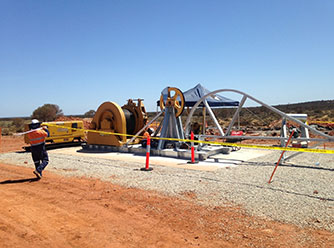IME Consultants (IMEC) is pleased to announce the successful completion of what is thought to be one of the deepest high voltage cable lowering installations in Australia. The cable was installed in a borehole from the surface for a total depth of 1372 metres.
KEY POINTS
- One of the deepest cable-lowering jobs in Australia (Greater than 1350m)
- Murray Engineering Pty Ltd engaged IME Consultants for engineering support of the project
- Cast cable clamps allowed for a borehole diameter of 250mm
- A final suspended mass of 19.55 tonnes
- Six-Day Installation Turn-around
The cable installation works formed part of an overall site power upgrade project to ensure supplies for mining activities for 2015 and beyond. Murray Engineering Pty Ltd (MEPL) appointed IME Consultants (IMEC) to provide multi-disciplinary engineering support for the projected.
The selected approach by the mine was to install the cable directly from surface to some of the deepest workings within the mine to minimise disruptions to mine production and provide the shortest path of transmission to the deepest sub-station within the mine. The successful implementation of the cable would also provide electrical redundancy for operations through a “Ring Main System” that would tie-in with the current underground feeds.
MEPL the lead contractor for the overall project engaged IMEC to support with design of all equipment and selection of materials required to safely lower and later suspend the cable down the 1372m deep borehole.
Traditionally cable installations similar in nature have utilised a mobile crane in which to suspend a sheave block over the borehole which allows the catenary rope to be wound out and directed down the borehole for coupling to the HV cable. The use of a mobile crane results in deflection (through the boom flexure and rope stretch to hook) which was foreseen to be a potential issue on a lowering of this magnitude due to the masses imparted on the rope during the later stages of the lowering. This dynamic loading on the crane would necessitate a very large trussed-type crane unit at a cost to the project.
Work commenced to develop a solution that would negate the requirement of a crane and provide a more robust solution. Taking roots from shaft sinking and historical gig rising methods, a skid-based arrangement with a winch and sheave structure was derived. The arrangement allowed for full testing of all equipment prior to mobilising to site, negated the need for a crane, reduced the number of working components comparative with traditional methods (to reduce risk of mechanical failures delaying lowering works) and developed a piece of equipment in which can be utilised for future lowering works by MEPL.
The methods used for coupling the HV Cable to the support catenary rope has varied from purpose built and designed clamps to simple band-it strapping. The risk identified by band-it strapping a cable to the support catenary rope over such a distance would be a significant as any hang-up in the borehole could potentially cut a strap and place excessive load on succeeding straps resulting in a failure and unplanned separation of the HV cable from the catenary rope this would be catastrophic to the works and jeopardise the whole project.
A purpose built and designed clamp was preferred and works to develop a prototype were commenced in March 2014. A trade-off between weight and strength was balanced to select a suitable material and general clamp design. Polymers and other thermoplastic products were initially reviewed due to their strength, resistance to corrosion and being a non-conductor. However the extreme environment that the clamps would be potentially exposed to onsite meant that the use of such materials would not be practical for long term strength. Grade 316 stainless steel was thus selected for the construction material for the clamp.
An additional challenge with the design of the clamp was ensuring its profile was kept to a minimum to fit down into the borehole. Increasing the borehole size would be extremely expensive for the client and so IMEC were able to design a clamp profile that allowed for the initial borehole diameter.
Having a smaller profile meant the clamp now required to be cast, rather than fabricated, however even with this increased cost, the net cost saving to the project over drilling a larger diameter hole was significant. A prototype unit was cast and a series of controlled pull tests were undertaken with rope and cable samples. Results from pull testing were correlated with theoretical modelling to finalise bolt torques and clamp spacing down the borehole.
IMEC then completed sizing of all appropriate equipment such as a winch to lower and support the arrangement until the final tie-off, catenary rope size, sheave sizing and all other ancillary items.
Lowering works commenced in November 2014. A team of MEPL employees and sub-contractors comprising of electricians and management staff were mobilised to site along with the presence of an IMEC Senior Engineer to oversee the installation in its entirety.
Stringent checks were carried out on all equipment to ensure no damage or tampering of items during transport had taken place. All items were factory tested prior to being mobilised to site including line pull testing, NDT of all lifting appliances, calibration of load cell, clamp pull testing and inspection of certs and data sheets in conformance with design requirements for all procured items.
Works duration for the lowering were 6 days from mobilisation to sign-off on the secured installation, which matched exactly with the project schedule.
The successful completion of a unique and challenging project was a tremendous result for both MEPL and IMEC.



